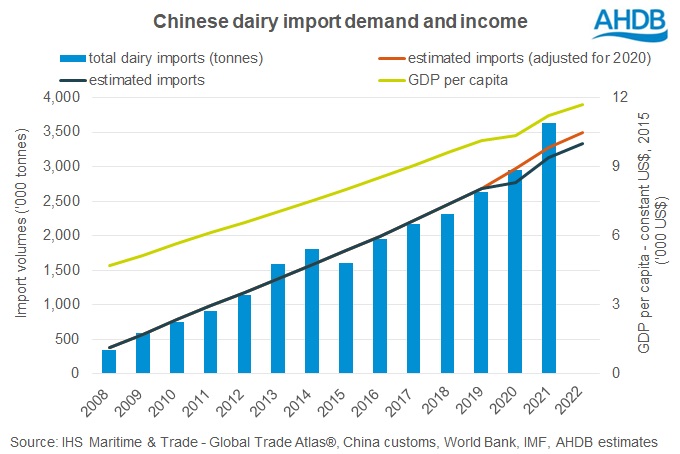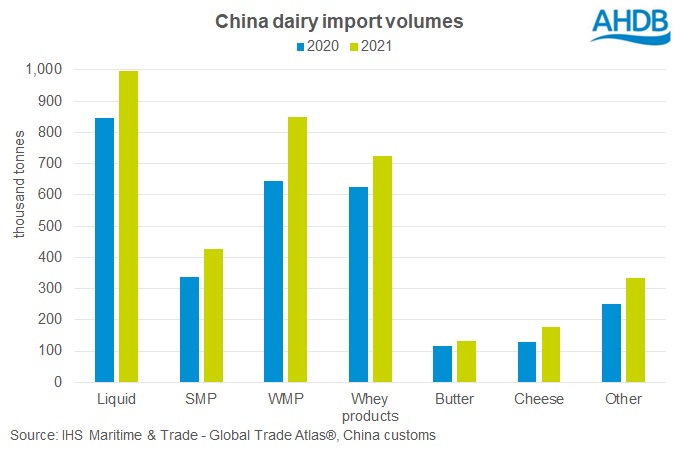Will Chinese dairy demand drop in 2022?
Wednesday, 18 May 2022
China’s demand for dairy products plays a pivotal role in setting the price direction on global dairy markets. Back in 2013 and 2014 they bought above expectations, which contributed to the collapse in global dairy prices when import demand slumped in 2015.
Historically there has been a strong relationship between China’s economic growth (as measured by GDP per capita) and its level of dairy imports. So much so that comparing the two trends can give an indication of whether import volumes are in line with demand, or contributing to stock building and posing a risk that import demand will fall away.
China’s buying unexpectedly strong in 2021
Although rising input costs and tight supplies are considered to be the main factors driving high dairy prices since summer 2021, demand has also been important. Strong demand, sustained even at higher prices, supported the market through 2020 and 2021, and China’s import demand played a central role in this.
In 2020, the pandemic curbed China’s GDP growth but didn’t seem to dampen import demand. Contracted shipments, plus the build-up of safety stocks to deal with logistical delays, appear to have kept imports on track with rising incomes. In 2021, China’s GDP growth bounced back despite the lingering effects of the pandemic. As for imports, they rose 23% year on year, far outstripping GDP-based expectations.

When we analysed this a year ago, the balance of products showed growth in liquid milk and whey but not in powders. This shifted in 2021, with liquid and whey products still growing year on year, but milk powder imports also seeing a large uplift, particularly for WMP.

What does this mean for China’s import demand later this year?
Based on China’s predicted economic growth[1] of 4.4% for 2022, import volumes were expected to increase by around 6.5% this year. However, this doesn’t account for the higher-than-expected level of imports in 2021. The build-up of safety stocks will account for some of these additional import volumes, but if manufacturers now start to use these stocks, import buying could be dented through 2022.
So far this year, we have seen a drop in dairy imports, with Q1 2022 volumes down 12% on Q1 2021. Imports of powders and concentrates still rose in the period, as did butter volumes, while all other product categories saw lower volumes year on year. For milk powders, this is a particularly important period as China generally makes its biggest purchases at the start of the year when they can take advantage of low tariff rates.
Going forwards, it is possible that we will see a drop-off in demand if China now considers itself sufficiently stocked, particularly due to lower consumer buying as parts of China are again facing lockdowns.
Although there is a delay to trade data, we have seen signs of reduced demand in the falling prices at GDT auctions. Additionally, according to Rabobank, “local market prices of imported WMP have also recently weakened due to ample stock and uncertain demand”. As a result, Rabobank are expecting China’s appetite for imports to be dampened in the second half of 2022.
Conclusion
There are some signs that a reduction in demand from China could be forthcoming, whether due to ample supplies or lower demand. If realised, this would put downwards pressure on markets and limit further upward moves in dairy product prices. However, with high inputs costs keeping global milk expectations tight, this will provide help to counterbalance some of that downwards pressure.
[1] International Monetary Fund GDP projection

Sign up to receive the latest information from AHDB.
While AHDB seeks to ensure that the information contained on this webpage is accurate at the time of publication, no warranty is given in respect of the information and data provided. You are responsible for how you use the information. To the maximum extent permitted by law, AHDB accepts no liability for loss, damage or injury howsoever caused or suffered (including that caused by negligence) directly or indirectly in relation to the information or data provided in this publication.
All intellectual property rights in the information and data on this webpage belong to or are licensed by AHDB. You are authorised to use such information for your internal business purposes only and you must not provide this information to any other third parties, including further publication of the information, or for commercial gain in any way whatsoever without the prior written permission of AHDB for each third party disclosure, publication or commercial arrangement. For more information, please see our Terms of Use and Privacy Notice or contact the Director of Corporate Affairs at info@ahdb.org.uk © Agriculture and Horticulture Development Board. All rights reserved.

